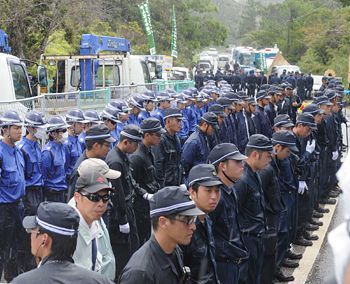Takae, a village ward of 140: “Not a single person is in favor” of helipad construction

Riot police sent in from all over Japan to enable the construction of new helipads in the U.S. military’s Northern Training Area. Takae residents say they feel terrible and there must be another way. July 22, Takae, Higashi Village
July 25, 2016 Ryukyu Shimpo
By Ayako Sakaguchi
As sit-in protests continue daily in opposition to the construction of new helipads in the U.S. military’s Northern Training Area, people from outside the village can be heard making comments such as, “Almost none of the locals are actually participating in the protests, are they?”
“There’s not a single person here in favor [of the helipad construction].” Takae resident Naohide Urasaki, 68, speaks in an emphatic tone in response to such criticism. Takae residents released resolutions opposing the helipad relocation at assembly meetings in 1999 and 2006. Nevertheless, Higashi Village Mayor Seikyu Iju accepted the relocation, and two of the six planned helipads have already been built. Urasaki himself almost never participates in the sit-ins protests. “I want to join the movement, but with my fields to tend to, I can’t spend the whole day there,” he explains.
The ward of Takae has only 140 residents, most of whom make a living as farmers. If a farmer neglects his fields for even a day, it will negatively affect his crops. Many people are opposed to the helipad construction but are unable to protest actively because their livelihoods are at stake.
Farmer Yoshikatsu Takaesu, 73, says, as though trying to convince himself, “The Osprey are noisy, and I oppose the helipads. But I have to prioritize being able to eat. How can I manage to eat if I spend my days at the sit-in protests?”
Ward chief Kumiko Nakamine, 66, says that she thinks of the residents of her ward as family. Her face shows fatigue as a result of endless questions from groups of reporters. “The policing is intense, and traffic has increased. I worry that it will negatively impact the lives of the residents here,” she says, expressing her concern.
Takashi Kiyuna, 45, says, “Because it is such a small ward, connections are very important to us. Many people aren’t saying things that they want to say.”
A man in his sixties spoke in a small voice, saying, “Some people find it hard to raise their voices, for instance because their son was able to find a job at the village office.”
Some commentary implies that politics are tearing Takae in two as the government pushes forward with the construction. Urasaki has been told by fellow Higashi villagers, “The situation in Takae is tough, isn’t it?” as though the situation had nothing to do with them. However, Urasaki says, “That’s not how it is. This is a national issue, and as residents of the same village, I want them to think about it. If the [Higashi] village leadership were to come out in opposition, I think everyone would come together and do their best. Takae isn’t being torn in two at all. Everyone is opposed.”
Okinawa Governor Takeshi Onaga has conveyed to the national government his opposition to the relocation of U.S. Marine Corps Air Station Futenma to Henoko, Nago City. The construction at Henoko is currently stopped. In the small ward of Takae, people struggle between a sense that even if they raise their voices, nothing will change, and a desire to see the situation change through a spread of awareness nationwide.
(English translation by T&CT and Sandi Aritza)
Previous Article:Ministry designation will help Kerama become an important tourist destination, attract tourists from abroad
Next Article:Swedish emigrant to Kumejima turns Okinawan old house into North European restaurant
[Similar Articles]
- Takae residents request removal of Osprey to ODB in light of recent crash accident
- “Drowns out the TV”: Residents share Takae updates on YouTube, including U.S. military noise pollution and waste
- US military carries out Osprey training at new helipad in Takae for the first time
- Takae residents protest against Japanese government agreeing to provide land for US helipads before returning region’s land occupied by US military
- Two protestors sustain injuries while opposing helipad construction in Takae
 Webcam(Kokusai Street)
Webcam(Kokusai Street)


